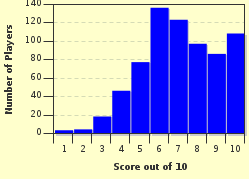Quiz Answer Key and Fun Facts
1. What were the legal orders, or estates, into which all French citizens were divided? (Highest to lowest)
2. On June 17th, 1789, the delegates of the Third Estate voted to call themselves by a new name. What was it?
3. On August 27, 1789, the National Assembly issued the Declaration of the Rights of Man and of the Citizen, France's new constitution. Which of the following was NOT part of the Declaration?
4. Which king and queen reigned in France during the Revolution?
5. The American Revolution was a great inspiration to the French people, and many volunteers actually fought against the British in America. Which Frenchman, hero of the American Revolution, became commander of Paris's armed forces after the storming of the Bastille?
6. Who began his career as a provincial lawyer, became a delegate of the National Convention, was a great orator who led one of the main factions of the Convention, and was the main voice behind the Reign of Terror (1793-1794).
7. Robespierre began his career taking the position against the death sentence, but later in his career, he clearly changed his position, and was a strong advocate for the guillotine, even sentencing some of his own friends to death. Delegates of the National Convention decided to conspire against Robespierre, and they shouted him down when he tried to speak next at the Convention. What was this called?
8. One of the more radical moves of the French Revolution was the attempted elimination of the Roman Catholic Church and Christianity by Robespierre during the Reign of Terror. What new religious idea did he want the people to accept?
9. One of the reasons the Revolution and the wars abroad were so successful was a strong feeling of patriotism and nationalism that swept across France. It was during the Revolution that France's national anthem emerged. What is it called?
10. After the fall of Robespierre, many changes followed. The population voted for electors, just as before, and these electors in turn elected members of a reorganized Legislative Assembly. However, this assembly now chose a five-man executive board. What was it called?
Source: Author
voilaviola
This quiz was reviewed by FunTrivia editor
bloomsby before going online.
Any errors found in FunTrivia content are routinely corrected through our feedback system.

